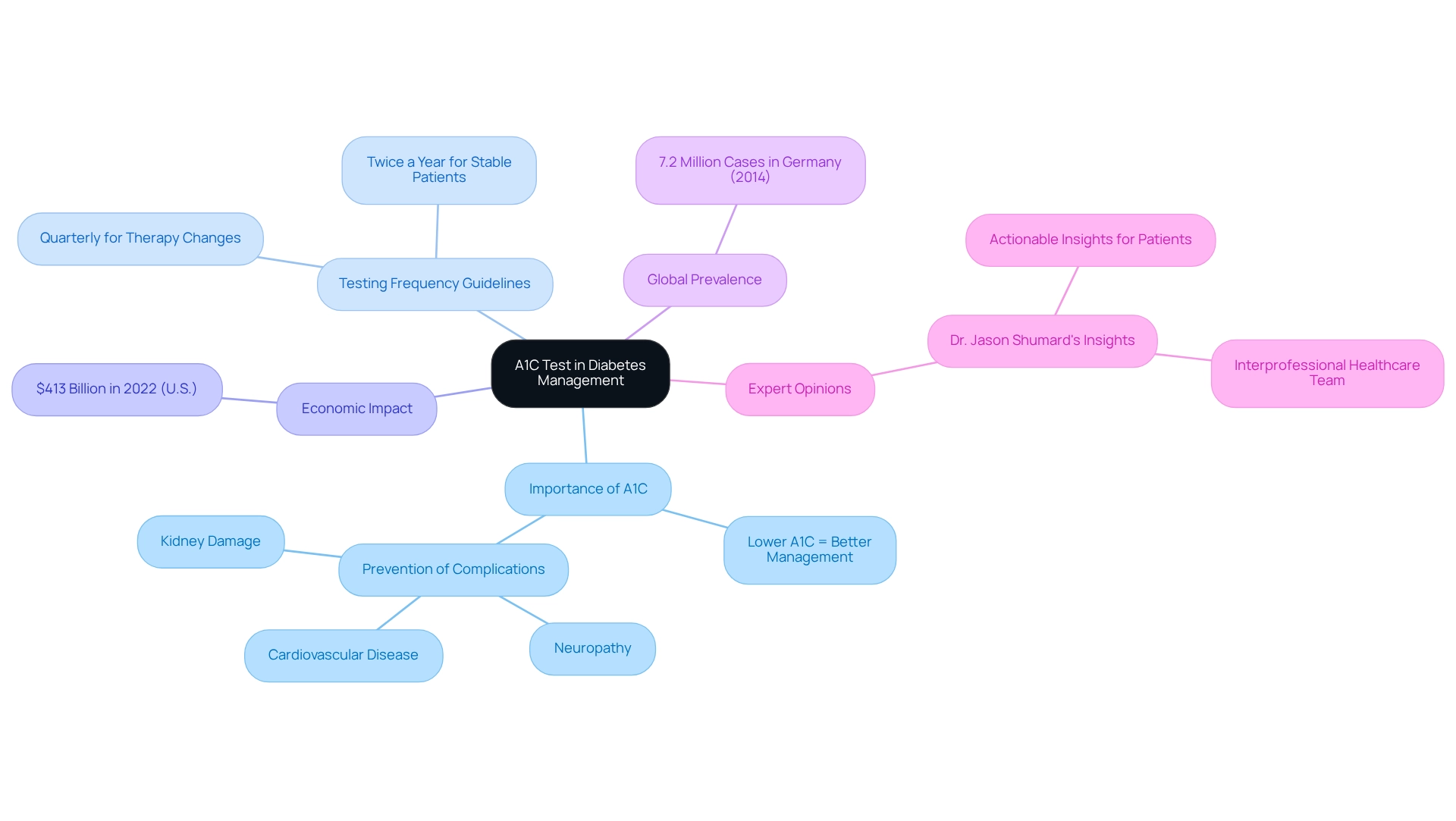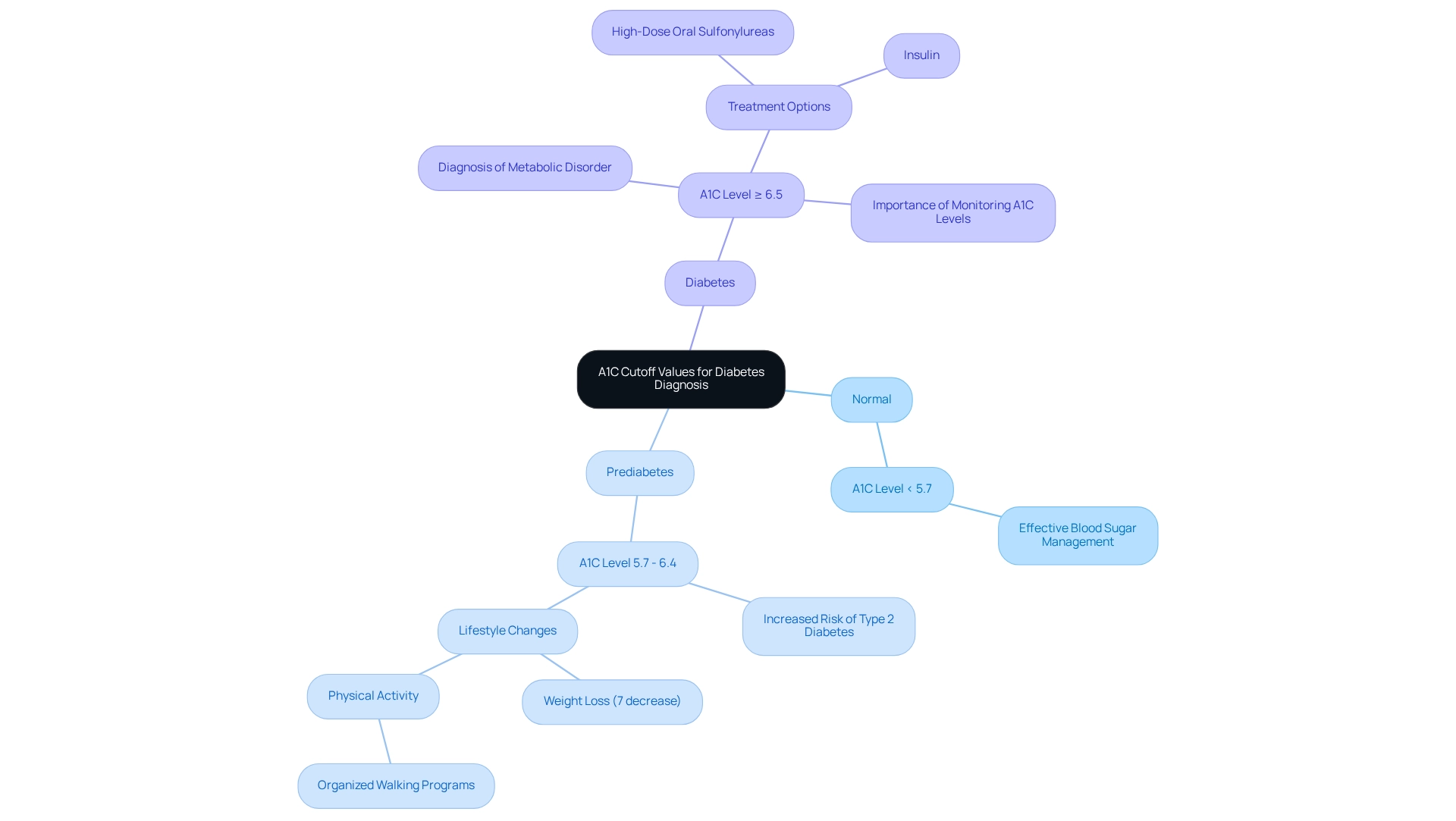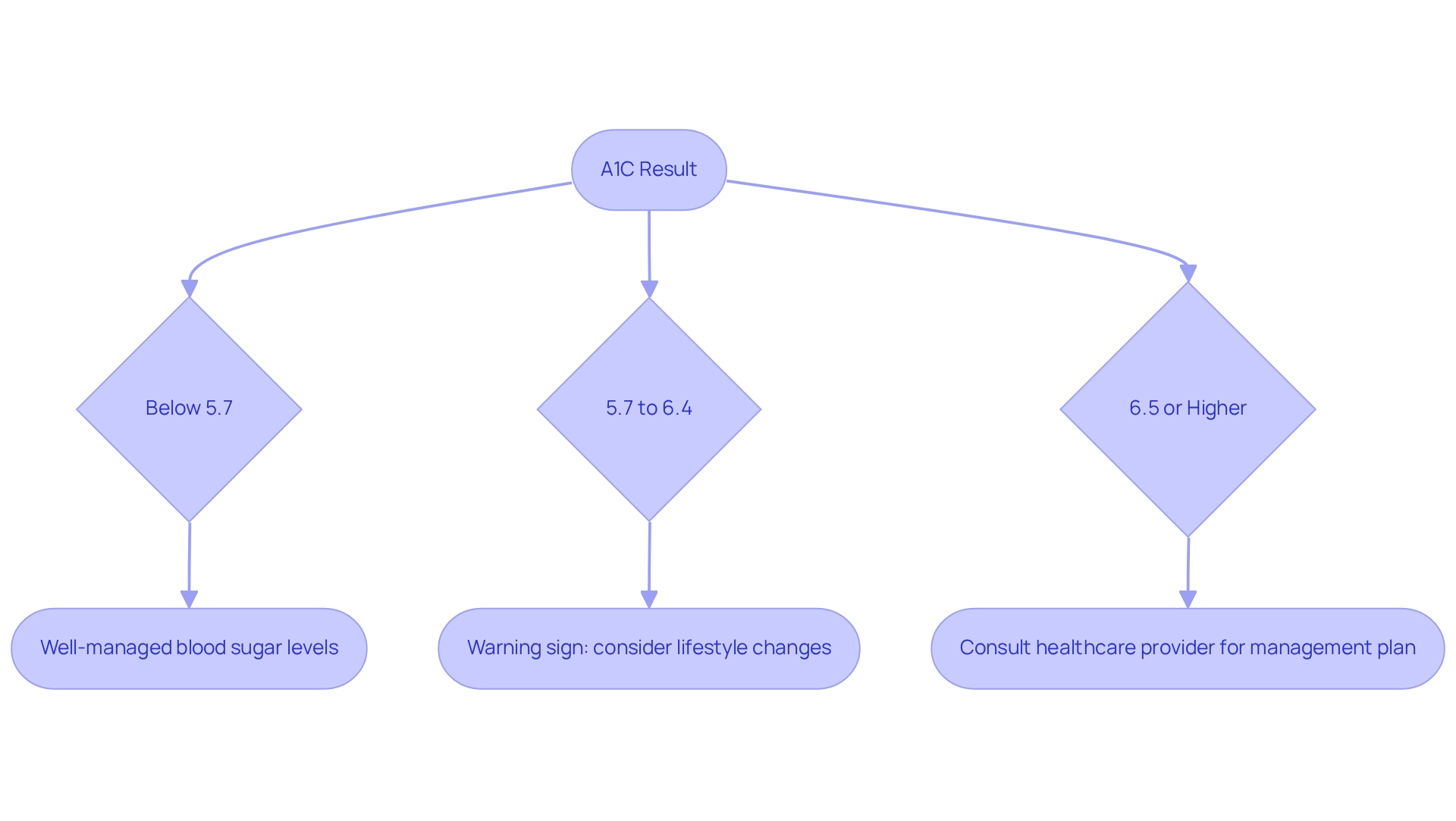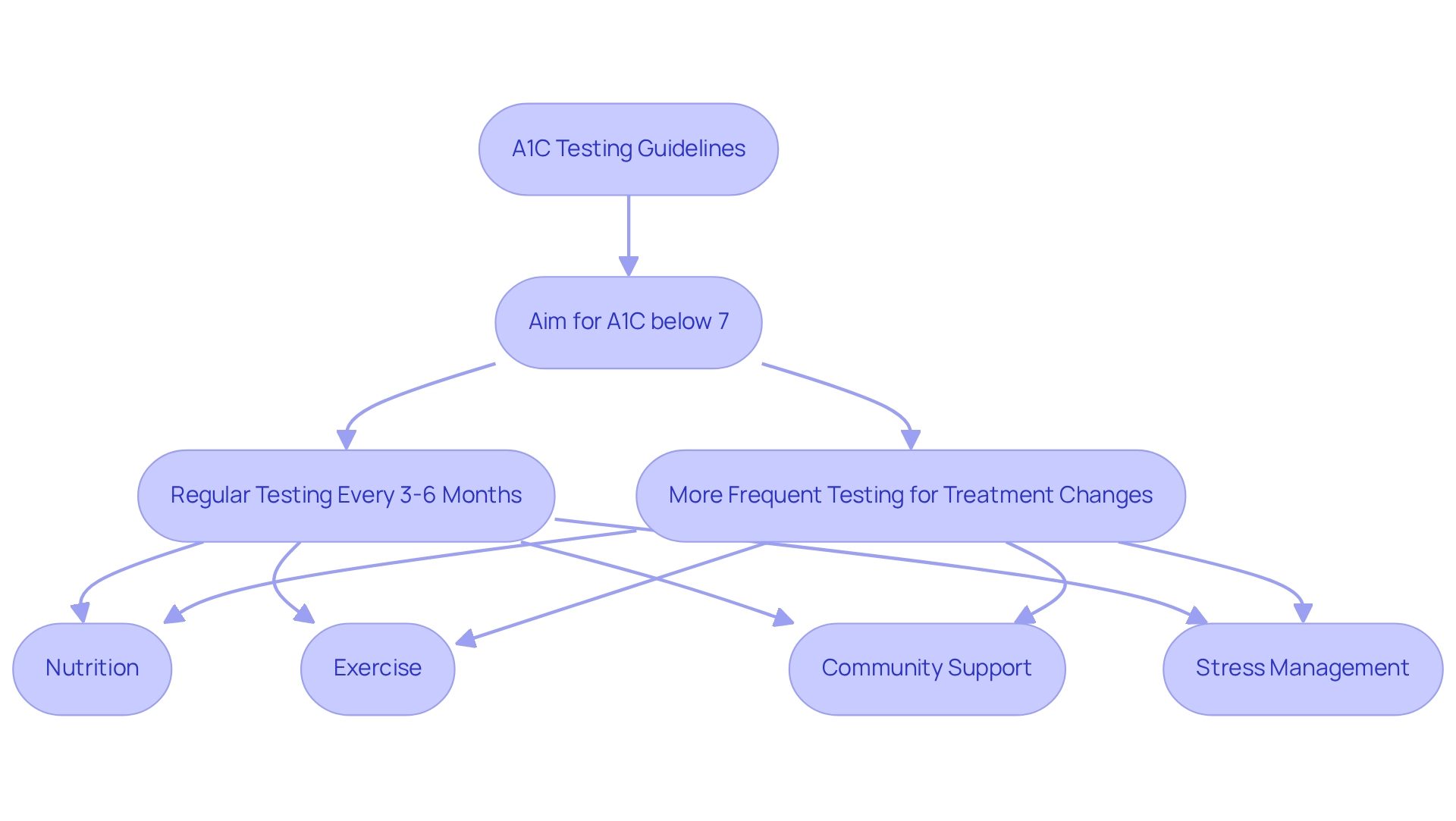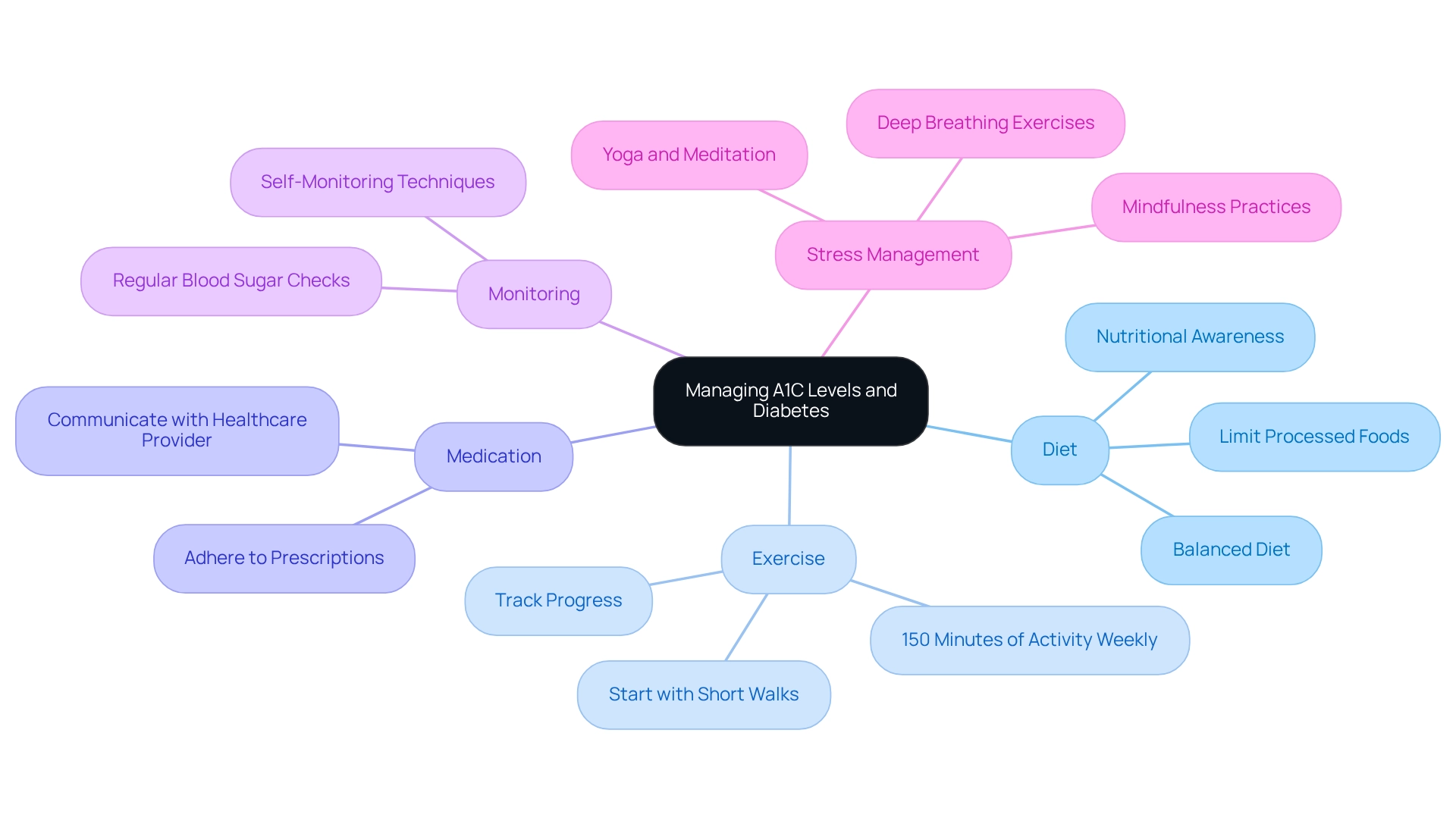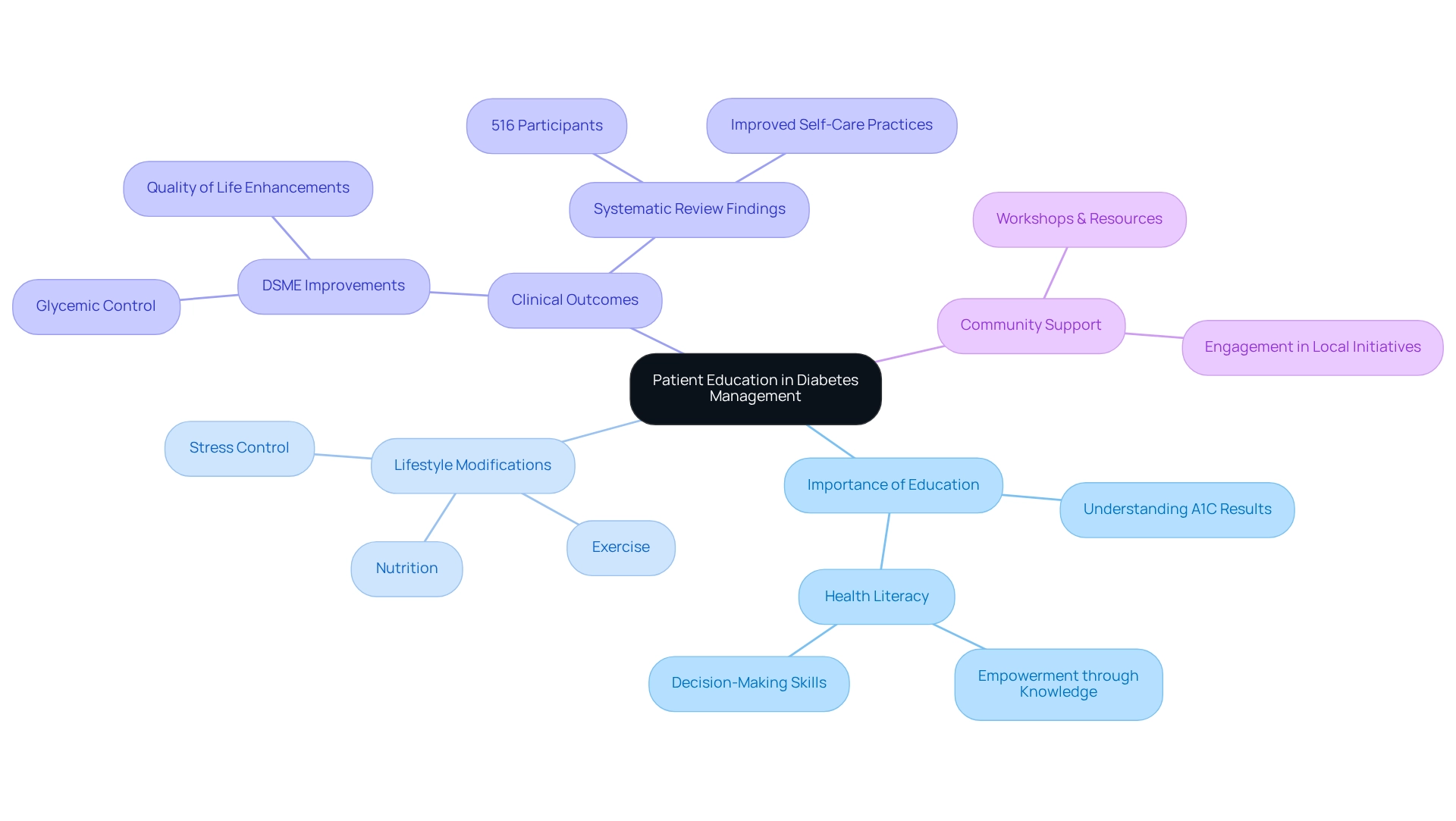Overview
This article highlights the vital role of understanding A1C cutoff values in effectively managing diabetes. It’s important to recognize that regular monitoring of A1C levels is not just a recommendation; it’s crucial for assessing long-term blood sugar control and preventing complications. Many patients find that adhering to guidelines, which recommend testing frequency based on individual treatment goals and health conditions, can make a significant difference in their health journey.
Have you ever felt overwhelmed by the complexities of diabetes management? You’re not alone. Many individuals share similar struggles, and it’s essential to approach this journey with compassion and understanding. By prioritizing A1C monitoring, you can take proactive steps toward better health.
Imagine the peace of mind that comes with knowing you’re actively managing your diabetes. Regular A1C testing can empower you to make informed decisions about your lifestyle and treatment. Embrace this opportunity to connect with your health care provider and discuss your personalized approach to diabetes management.
In conclusion, remember that you are not in this alone. Support and resources, like the 30-Day Diabetes Reset program, are available to guide you on this path. Together, we can navigate the challenges of diabetes with empathy and strength.
Introduction
In the journey of diabetes management, the A1C test serves as a vital guide, illuminating the way toward better health. This important measure not only reflects average blood sugar levels over the past few months but also acts as a key indicator of long-term glycemic control.
It’s important to recognize that as the global diabetes epidemic continues to escalate, understanding the significance of A1C testing becomes essential for both patients and healthcare providers.
With statistics revealing staggering costs and widespread cases of diabetes, many patients find that proactive monitoring of A1C levels can lead to timely interventions, personalized treatment plans, and ultimately, improved health outcomes.
This article explores the importance of A1C testing, its interpretation, and practical strategies for effective diabetes management, empowering individuals to take charge of their health journey.
What is A1C and Why is it Important in Diabetes Management?
The A1C test, or hemoglobin A1C, is an essential tool for managing blood sugar levels. By assessing average glucose levels over the past two to three months, this test helps us understand how well we are controlling our health. Expressed as a percentage, it reflects the proportion of hemoglobin molecules with glucose attached. A lower A1C percentage indicates improved blood sugar management, which is vital for preventing serious complications like cardiovascular disease, kidney damage, and neuropathy.
At Integrative Wellness Center, we believe that regular testing at the A1C cutoff is not just a recommendation; it’s a crucial part of managing blood sugar conditions effectively. Current guidelines recommend that individuals with this condition have their A1C levels checked at least twice a year if they are meeting treatment goals, and quarterly if their therapy has changed or if they are not meeting the A1C cutoff. This proactive approach allows for timely adjustments to treatment plans, ensuring optimal health outcomes tailored to each patient’s unique needs.
It’s important to recognize that managing blood sugar can feel overwhelming. Statistics show that in the U.S., the total projected expenses for diagnosed cases of this health condition reached a staggering $413 billion in 2022, highlighting the economic burden associated with it. Furthermore, Germany recorded more than 7.2 million instances of the condition as of 2014, emphasizing the worldwide magnitude of this epidemic. Many patients find that approximately 50% of individuals with blood sugar issues regularly monitor their A1C levels, revealing a significant gap in adherence that could impact their health outcomes.
The significance of the A1C test extends beyond mere numbers. The A1C cutoff serves as a vital indicator of long-term glycemic control. Recent studies emphasize the importance of standardization in A1C testing methods to ensure accuracy and reliability across different healthcare settings. This standardization is essential for effective control of blood sugar levels, as it enables healthcare providers to make informed choices based on consistent information.
Examining HbA1c testing techniques and standardization highlights that these initiatives are vital for enhancing the accuracy of A1C measurements, which is crucial for efficient management and monitoring of blood sugar levels.
Expert opinions consistently affirm that the A1C test and the A1C cutoff are invaluable in managing blood sugar conditions and glycemic control disorders. It functions best within an interprofessional healthcare team environment, where various specialists collaborate to optimize patient care. As Dr. Jason Shumard states, “By offering patients actionable insights and practical tools, the center cultivates an atmosphere where individuals can regain their wellness and well-being.”
This empowerment is essential in the context of A1C testing and oversight, allowing patients to take charge of their well-being through tailored functional medicine strategies.
In summary, the A1C test is not just an indicator of blood sugar levels; it’s a comprehensive tool that plays a pivotal role in managing the condition. Regular monitoring can significantly influence treatment strategies and wellness outcomes, making it an essential element of any care plan at Integrative Wellness Center.
Reach out to us today to discover how Dr. Shumard can assist you in managing your condition effectively and restoring your health!
Understanding A1C Cutoff Values for Diabetes Diagnosis
The A1C test results are classified into three distinct categories: Normal, Prediabetes, and Diabetes. An A1C level below 5.7% is deemed normal, reflecting effective blood sugar management. When the A1C level falls between 5.7% and 6.4%, it indicates prediabetes, which is linked to an increased risk of advancing to type 2.
A level of 6.5% or greater confirms a diagnosis of a metabolic disorder.
These cutoff values are not just figures; they are crucial for applying early intervention strategies that can greatly change wellness outcomes. For example, studies indicate that individuals with prediabetes can lower their risk of developing type 2 by 58% through lifestyle changes, such as attaining a 7% decrease in body weight and participating in moderate physical activity, including organized walking programs. This underscores the importance of proactive health management based on A1C results.
Current statistics reveal that a substantial portion of the population is affected by these conditions, with many individuals unaware of their prediabetic status.
Significantly, women identified with gestational diabetes mellitus (GDM) face an increased risk of developing prediabetes and type 2 health issues later in life. The American Diabetes Association® emphasizes the need for ongoing research and resources to support those battling diabetes, highlighting the critical role of education and awareness in managing these chronic conditions. Furthermore, a significant statistic indicates that 30–50% of individuals with K-related neonatal diabetes exhibit improved glycemic control when treated with high-dose oral sulfonylureas instead of insulin, showcasing the importance of tailored treatment options. Understanding the A1C cutoff values is essential for both patients and healthcare providers. Expert analysis indicates that consistent tracking and prompt actions based on A1C levels can result in enhanced well-being and a better quality of life.
By acknowledging the importance of the A1C cutoff thresholds, individuals can take informed measures to effectively manage their well-being. As emphasized by H.C.J., the significance of examining and comprehending these metrics cannot be exaggerated, as they play an essential role in the care of individuals with blood sugar issues. Furthermore, transformative patient experiences, like those recounted by participants in Dr. Jason Shumard’s 30-Day Diabetes Reset program, demonstrate how holistic methods and lifestyle modifications, including walking, can result in substantial advancements in overall wellness and well-being.
To effectively start a walking routine, individuals should refer to the walking program PDF for a structured method. Begin by evaluating your current fitness level and establishing realistic goals, such as committing to a daily walk of 10-15 minutes. Selecting an appropriate environment is crucial; ensure it aligns with your safety and comfort preferences, whether that be indoors or outdoors.
Developing a consistent schedule is imperative, with an emphasis on gradually increasing both the duration and frequency of your walks over time. Tracking your progress is also highly beneficial; utilizing a journal or an app can help maintain motivation and allow you to celebrate your achievements along the way. Furthermore, consider joining a hiking group or partnering with a companion to enhance accountability and enjoyment.
By adhering to these guidelines, novices can develop a lasting walking program PDF that greatly enhances their overall wellness and vitality.
Interpreting A1C Results: What Do the Numbers Mean?
Understanding the A1C cutoff results is crucial for effective control of blood sugar levels, as different percentages indicate varying states of health. An A1C cutoff below 5.7% signifies well-managed blood sugar levels, suggesting that the individual is maintaining a healthy lifestyle. Conversely, an A1C cutoff range between 5.7% and 6.4% serves as a warning sign, indicating the need for lifestyle modifications to prevent the onset of diabetes.
When the A1C reaches 6.5% or higher, it becomes imperative to consult with a healthcare provider to establish a comprehensive management plan tailored to your needs. It’s important to recognize that A1C results can vary due to several personal factors, including age, ethnicity, and general well-being. For instance, recent statistics reveal that there were 5,293 newly diagnosed cases of type 2 diabetes among children and adolescents aged 10 to 19, highlighting the need for early intervention and education regarding A1C levels in younger populations.
Comprehending what various A1C percentages signify for well-being, especially in relation to the A1C cutoff, is essential. An A1C cutoff of 5.7% to 6.4% may indicate prediabetes, a condition that affects millions and can lead to more severe medical issues if not managed. Moreover, average medical costs among individuals with diagnosed conditions related to blood sugar regulation are 2.6 times greater than what expenses would be without such conditions, highlighting the financial impact of effective management.
Dr. Jason Shumard emphasizes, “By offering patients actionable insights and practical tools, the center promotes an atmosphere where individuals can regain their wellness and well-being.” This dedication to patient education and empowerment is crucial in managing the condition effectively. Many patients find that by employing techniques like SMART goal-setting and regular progress monitoring—through tools such as fitness applications, journals, and pedometers—they can foster a sense of accomplishment and sustain involvement in their well-being.
Consistent observation and analysis of A1C results, particularly the A1C cutoff, are essential elements of care for individuals with diabetes. This enables patients to take proactive measures toward enhancing their well-being. The center’s holistic strategy, as shown in transformative patient experiences, illustrates how personalized care and education can lead to better outcomes related to blood sugar control. For instance, patients have indicated considerable enhancements in their condition and well-being, reinforcing the effectiveness of the center’s approach.
By addressing both wellness and financial implications, patients can better grasp the significance of effective management of their condition.
Current Guidelines and Research on A1C Testing
The American Diabetes Association (ADA) recognizes the challenges faced by adults living with diabetes and recommends that most individuals aim for an A1C level below the cutoff of 7%. However, it’s important to understand that personal targets may vary based on unique health conditions and associated risks. The 2025 Standards of Care stress the necessity of regular testing at the A1C cutoff, suggesting evaluations every three to six months to effectively monitor blood sugar control.
For those who are struggling to meet their goals or are experiencing changes in treatment, this frequency of testing becomes even more crucial. More frequent assessments may be necessary to ensure optimal control and support your journey toward better health.
Recent studies have underscored the importance of A1C levels in assessing long-term glucose management and have highlighted the significance of the cutoff in relation to the risk of diabetes-related complications. For instance, research indicates that certain groups, including 11% of African American individuals in the U.S., may experience fluctuations in A1C levels due to genetic factors, which can influence treatment strategies. This highlights the need for personalized approaches in managing diabetes, ensuring that care is tailored to meet the distinct needs of each individual.
In San Marcos, CA, managing type 2 diabetes can be enhanced through holistic lifestyle strategies that emphasize nutrition, exercise, community support, and stress management. Many find that embracing the local outdoor lifestyle by utilizing parks and trails for regular exercise can significantly boost insulin sensitivity and improve blood sugar control. Additionally, focusing on a balanced diet rich in local produce, such as avocados and berries, can support overall health and help regulate blood sugar levels.
The ADA’s updated guidelines also provide practical strategies for healthcare professionals, promoting a comprehensive approach to managing diabetes that integrates nutrition, medication, and technology into care plans. As Charles “Chuck” Henderson, the ADA’s chief executive officer, beautifully puts it, “Enhancing the lives of individuals impacted by this condition is a key part of the ADA’s mission.” By following these guidelines and engaging with community wellness initiatives, patients can take proactive steps in managing their condition, ultimately leading to improved health outcomes and a better quality of life.
Practical Strategies for Managing A1C Levels and Diabetes
Effectively managing A1C levels can feel overwhelming, but it’s important to know that a multifaceted approach combining lifestyle modifications with medical guidance can make a significant difference, especially regarding the A1C cutoff. Here are some key strategies to consider:
-
Diet: Emphasizing a balanced diet rich in whole grains, lean proteins, and plenty of fruits and vegetables is vital. Limiting processed foods and sugars is crucial, as our dietary choices greatly influence A1C levels. Research shows that enhanced nutritional awareness can lead to better treatment adherence and fewer complications for those with diabetes. Many patients have shared their journeys, highlighting the need for improved dietary understanding and its significance in effective health care.
-
Exercise: Engaging in regular physical activity is essential for lowering blood sugar levels. Aim for at least 150 minutes of moderate exercise each week, such as walking, swimming, or cycling. If you’re unsure how to start a walking routine, consider referring to the walking program PDF for a structured approach. Begin by evaluating your current fitness level and setting realistic goals, such as committing to a daily walk of 10-15 minutes. Many find that regular exercise leads to substantial improvements in A1C levels, which is crucial for maintaining levels below the A1C cutoff. It’s worth noting that 70.8% of U.S. adults aged 18 years or older with diagnosed blood sugar issues also have elevated blood pressure, underscoring the importance of comprehensive wellness oversight alongside A1C management. Tracking your progress using a journal or an app can help keep you motivated and allow you to celebrate your achievements along the way.
-
Medication: Adhering to prescribed medications and maintaining open communication with your healthcare provider is essential. Proper medication administration can help stabilize blood sugar levels and promote overall well-being.
-
Monitoring: Regularly checking your blood sugar levels allows you to see how different foods and activities affect your A1C. This self-monitoring is a powerful tool for making informed dietary and lifestyle choices.
-
Stress Management: Incorporating stress-reducing techniques such as yoga, meditation, or deep breathing exercises can positively influence blood sugar levels. It’s crucial to remember that managing stress effectively is a key component of blood sugar control. Functional medicine integrates practices like mindfulness and relaxation exercises, helping to reduce stress that can elevate blood sugar levels.
Integrating these strategies not only aids in regulating A1C levels but also empowers you to take charge of your well-being concerning the A1C cutoff. Recent discussions on managing diabetes have emphasized the importance of addressing unmet needs, such as nutritional treatment, weight control, and psychological support, for comprehensive care. As Dr. Jason Shumard wisely states, “By providing patients with actionable insights and practical tools, the Integrative Wellness Center fosters an environment where individuals can reclaim their health and well-being.”
Focusing on education and practical tools can significantly enhance your quality of life and reduce reliance on conventional medical interventions. If you need more details or assistance in managing your condition, don’t hesitate to reach out to the Integrative Wellness Center today.
The Role of Patient Education in Effective Diabetes Management
Patient education serves as a vital foundation in effectively managing this condition, especially when it comes to understanding A1C results and the various factors that influence blood sugar levels, including the A1C cutoff. Many individuals with type 2 diabetes find that self-management education (DSME) significantly enhances their lifestyle modifications and self-care practices, leading to improved clinical health outcomes. A systematic review involving 516 participants revealed that those engaged in DSME interventions saw notable improvements in their glycemic control, highlighting the crucial role of education in blood sugar management.
At Integrative Wellness Center, we embrace a transformative approach to managing blood sugar issues, empowering patients to take charge of their health through holistic solutions and education. Our programs emphasize the importance of lifestyle modifications, such as nutrition, exercise, and stress control, tailored specifically to the unique environment of San Marcos, CA. Workshops, seminars, and informational materials serve as invaluable resources, equipping patients with the knowledge they need to effectively manage their condition.
These educational platforms not only provide insights into blood sugar management but also foster a collaborative atmosphere where patients can connect with healthcare professionals and educators. This interaction encourages patients to ask questions, share experiences, and learn from one another, ultimately enhancing adherence to treatment plans.
The impact of diabetes education programs on A1C cutoff levels is significant. By empowering patients with the tools and knowledge to take control of their well-being, these programs facilitate better decision-making and self-management. As Dr. Ken Moritsugu, an expert in the field, emphasizes, “DSMES contributes to an individual’s ability to achieve health literacy: to hear, understand, and embrace the message, and to ultimately put the information into action.”
This comprehensive strategy for blood sugar control not only improves clinical metrics but also enhances the overall quality of life for patients.
In light of recent discussions within healthcare systems, there is a growing recognition of the value of care and education specialists (DCESs) as essential partners in managing diabetes-related health. Their expertise is crucial in providing personalized educational strategies that resonate with patients, further underscoring the need for ongoing support and resources in health education. By prioritizing patient education, healthcare providers can significantly improve health outcomes and empower individuals to reclaim their health.
Furthermore, engaging in community wellness initiatives in San Marcos can provide invaluable support for managing type 2 conditions, offering tailored guidance and resources to help you integrate healthy habits into your daily life.
Key Takeaways: Mastering A1C for Better Diabetes Control
Mastering A1C is essential for effective management of blood sugar levels. It’s important to recognize that understanding your A1C can feel overwhelming, but it plays a crucial role in your health journey. Here are some key points to consider:
- The A1C test is vital for tracking long-term blood sugar levels and identifying health issues. It offers a thorough perspective on glucose control over time.
- Grasping A1C cutoff values is essential for recognizing risk levels. This understanding can facilitate timely actions that may avert complications linked to blood sugar issues.
- Routine A1C testing, according to current guidelines, is essential for effective control of blood sugar levels. This enables modifications in treatment plans as necessary.
- Implementing practical strategies—such as maintaining a balanced diet, engaging in regular physical activity, and adhering to prescribed medications—can lead to significant improvements in A1C levels.
- Patient education is a fundamental aspect of managing blood sugar levels. It equips individuals with the information and resources essential to take charge of their health.
Many patients find that recent advancements in blood sugar regulation highlight the significance of these strategies. Quality enhancement efforts, like those at Tulane Medical Group, have concentrated on boosting provider outreach and patient awareness, all in accordance with the American Diabetes Association (ADA) guidelines. These initiatives emphasize the necessity for innovative strategies in managing blood sugar conditions. Notably, the use of glucose-lowering medications has remained stable since 2010.
Statistics reveal concerning trends in hospital safety, with 7,000 incorrect medications given to patients and 80,000 infections acquired in hospitals. This underscores the critical need for a patient-centered approach to healthcare, as exemplified by Dr. Jason Shumard’s Integrative Wellness Center. Case studies illustrate the effectiveness of a holistic approach to health.
Patients like Ed have transformed their lives through personalized care and education, experiencing improved quality of life and reduced reliance on conventional medical interventions. As Ed shares, “If you have the opportunity to join this family, DO IT! It will be the most important choice you will ever make in your life.”
This highlights the importance of comprehending A1C not merely as a figure, but as a crucial factor in mastering control over this condition. By focusing on A1C mastery, individuals can achieve better control over their diabetes, leading to healthier outcomes and enhanced well-being. To learn more about how Dr. Jason Shumard’s personalized functional medicine approach can help you, contact us today at DrShumard.com or call (858) 564-7081.
Conclusion
Understanding and managing A1C levels is fundamental for individuals navigating the complexities of diabetes. It’s important to recognize that the A1C test serves as a critical barometer for gauging long-term blood sugar control, with its results directly influencing health strategies and interventions. By acknowledging the importance of regular A1C monitoring and adhering to established guidelines, individuals can proactively address their diabetes management, leading to better health outcomes.
Many patients find that mastering A1C is not merely about achieving a specific number; it encompasses a comprehensive approach involving lifestyle changes, education, and tailored medical care. With practical strategies such as:
- Balanced nutrition
- Regular exercise
- Medication adherence
- Stress management
Individuals can significantly improve their A1C levels, ultimately enhancing their quality of life.
Moreover, the role of patient education cannot be overstated. Empowering individuals with knowledge and resources fosters a collaborative environment where they can take charge of their health journey. As diabetes management continues to evolve, integrating holistic approaches and community support remains crucial in navigating this chronic condition.
By prioritizing A1C mastery, individuals not only work towards better diabetes control but also pave the way for a healthier, more fulfilling life. Embracing these strategies and seeking continuous support can lead to transformative changes, reinforcing the notion that informed and proactive management is key to overcoming the challenges posed by diabetes.
Frequently Asked Questions
What is the A1C test and why is it important?
The A1C test, or hemoglobin A1C, measures average blood sugar levels over the past two to three months. It helps assess how well blood sugar is being managed and is expressed as a percentage. A lower A1C percentage indicates better blood sugar management, which is crucial for preventing complications such as cardiovascular disease, kidney damage, and neuropathy.
How often should individuals with blood sugar conditions get their A1C levels checked?
Current guidelines recommend that individuals meeting treatment goals have their A1C levels checked at least twice a year. If therapy changes or if they are not meeting the A1C cutoff, it is advised to check levels quarterly.
What are the classifications of A1C test results?
A1C results are classified into three categories: Normal (below 5.7%), Prediabetes (5.7% to 6.4%), and Diabetes (6.5% or greater). These classifications are important for implementing early intervention strategies to improve health outcomes.
What lifestyle changes can help reduce the risk of developing type 2 diabetes?
Individuals with prediabetes can lower their risk of developing type 2 diabetes by 58% through lifestyle changes such as achieving a 7% reduction in body weight and engaging in moderate physical activity, like organized walking programs.
What is the economic impact of blood sugar conditions in the U.S.?
The total projected expenses for diagnosed cases of blood sugar conditions in the U.S. reached $413 billion in 2022, highlighting the significant economic burden associated with these health issues.
Why is standardization in A1C testing methods important?
Standardization in A1C testing ensures accuracy and reliability across different healthcare settings, which is essential for effective blood sugar management and enables healthcare providers to make informed decisions based on consistent data.
How can patients take charge of their health regarding A1C testing?
Patients can empower themselves by understanding A1C cutoff values and actively monitoring their levels. Engaging in tailored functional medicine strategies and collaborating with healthcare professionals can enhance their well-being.
What are some benefits of a walking program for managing blood sugar levels?
A walking program can improve overall wellness and well-being. It is crucial to start with realistic goals, gradually increase duration and frequency, and track progress to maintain motivation and achieve health benefits.
What role does education and awareness play in managing diabetes?
Education and awareness are critical for individuals battling diabetes, as they help in understanding the condition, recognizing prediabetes status, and taking informed actions to manage their health effectively.
